
Extracted from The History of Nevada, Volume 2, edited by Sam P. Davis, published in 1913 by Elms Publishing Company, Reno, Nevada, pages xxx-xxx.
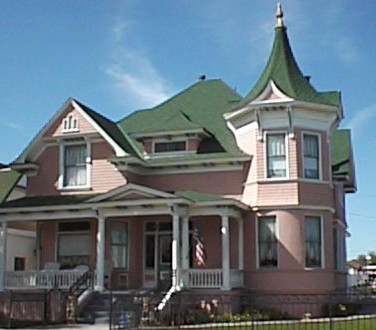
THE FIRST EXPLORERS who visited this vast land, beginning in the late 1820's, were drawn by the lure of fur. They passed on into California and left nothing but their footprints upon the desert sand. It took the promise of "Paradise" to entice the first emigrants in 1841, but once they passed, the sounds of their westward-bound wagons were quickly replaced by restless winds.
THE DISCOVERY OF GOLD IN CALIFORNIA, in 1849, profoundly affected the land we now know as Churchill County. The main trail to promised riches followed the Humboldt River to its destination the sands of the Humboldt Sink, crossed the dreaded "Forty Mile Desert" to the Carson River and then meandered west. In one year, over 25,000 people crossed that desert in wagons, on foot and on horseback. Many recalled the horror of their trek across the desert, and many more did not live to tell the tale.
THE FIRST PERMANENT SETTLEMENT in Churchill County was called "Ragtown". It was an emigrant station established in 1855 by Asa Kenyon and his wife Catherine to sell provisions to those who survived the perilous crossing. The name probably came from emigrants who washed their clothing and hung it to dry on the trees and bushes.
IN 1858, THE DISCOVERY OF SILVER in the canyon below Mt. Davidson (near Virginia City), changed forever the destiny of that part of Utah Territory which was to become Nevada. The concerns of Union supporters to keep the silver of Nevada for the North spurred the drive for statehood, and with a strained relationship growing between the Northern and Southern states, rapid communications with the West became a major concern. In 1860 the famed Pony Express crossed the nation from St. Louis, Missouri to California, bringing news in less than ten days. The change stations at Cold Springs, Fairview, Sand Springs and Sink Station are an important part of this story. In the footsteps of the ponies came the Overland Telegraph and eighteen months later the East and West were linked by the wires of progress. Cannon fire at Fort Sumpter signaled the beginning of the Civil War and the echo was heard across the West.
IN 1861 CHURCHILL COUNTY WAS CREATED, with Bucklands Station its provisional county seat. In 1863 the seat of government was moved to the small mining town of La Plata, in the Stillwater Range. This early period was marked with scattered farms and freight stations which were established to support the growing traffic to the new silver discoveries in Austin. Salt and soda were two of the most important minerals extracted in the County. Soda from Soda Lake won a gold medal at the 1876 Philadelphia Exposition.
IN 1867, WITH MINING ON THE DECLINE in Churchill County, Stillwater became the third home for county government. This little town, in the heart of the farming area, had a small but growing population. It housed the county government until 1903.
THERE ALWAYS HAVE BEEN MEN OF VISION, and Nevada possessed many such men. The key to overpowering the desert was water. Beginning in the 1890's, a way was sought to tame the land and provide the necessary water to develop the rich soils found in many areas. Henry Fulton and Francis G.Newlands were two who helped make this a reality.
AT THE TURN OF THE CENTURY FALLON DID NOT EXIST! At the dusty crossroads between St. Clair and Stillwater, which the local Indians called "Jim's Town", stood Mike Fallon's ranch house and a small store run by Jim Richards. Mike and his wife, Eliza Bruner Fallon, settled there in 1896, and had the post office at their ranch. Speculation about a project to build a dam and canal to irrigate or "reclaim" the desert lands was a focus of conversations among far flung residents. For many years, Congress had kept a western irrigation bill from being passed. Following the assassination of President McKinley in September of 1901, the long-time conservationist Theodore Roosevelt became President. The Reclamation Act of 1902, which was signed by President Roosevelt on June 17, 1902, established a federal reclamation system financed from the sale of public land, and created the United States Reclamation Service.
THE DUSTY CROSSROADS CALLED JIMTOWN would never be the same. Mike Fallon sold his ranch to Warren W. Williams, who proceeded to have the land platted and began advertising the sale of lots. In 1903, then State Senator Williams, pushed through legislation that formally moved the county seat from Stillwater to the new town of Fallon. This fourth and final home for local government gave Churchill County the distinction of having had the most county seats of any county in the State.
WILLIAMS LAID OUT THE WEST SIDE
from the old Fallon Ranch. He named the main street after his native state, Maine. The other streets, Bailey, Allen, Taylor and others were named for friends. The eastern part of the new town was established on land owned by John Oats. In 1903 work began on the new courthouse, and it was ready to be occupied that year.
Part of local folklore includes the
tale that residents of Stillwater resented the "theft" of the county seat
and would not allow records to be moved to the new courthouse. The tale
continues that residents of Fallon came to Stillwater in the dead of night
and loaded the records into wagons. When they were discovered, they were
chased all the way to Fallon by Stillwater residents. After the move of
the courthouse, many Stillwater businesses followed and moved to Fallon.
One of the earliest was the I.H. Kent Company, which celebrated its 100th
year in Churchill County in 1992.
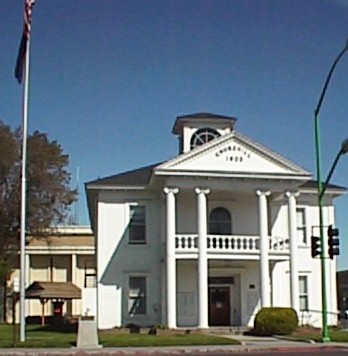
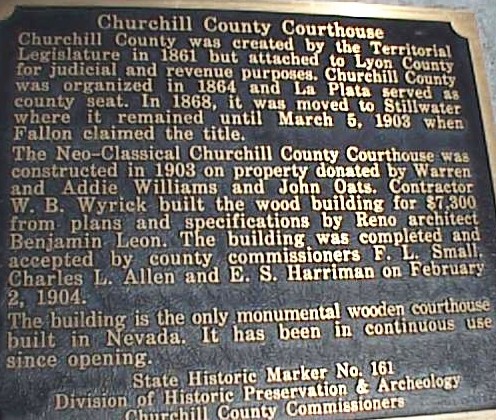
FROM THE VERY BEGINNING, Fallon grew and prospered with the new irrigation project. Work began on the Truckee River, with the building of Derby Diversion Dam, in June, 1903. A thirty-one-and-a-half mile canal to the Carson River also was started. The first water from the Truckee River reached the Carson River on June 17, 1905, when the dam was formally dedicated.
THE CHURCHILL COUNTY TELEPHONE & TELEGRAPH SYSTEM was formed in 1889, with the first switchboard being installed at Stillwater. By 1907 the Telephone Company had moved to Fallon. Now in its 2nd century of operation, the local company is the only County owned and maintained telephone company in the United States.
AFTER VOTERS IN THE CITY REJECTED
a special incorporation act in 1907, the City finally was incorporated
in 1908 under a general incorporation act. It was the goal of the new city to provide the finest in services to its residents. With large groups of people expected to homestead the newly reclaimed farm lands, a population of 20,000 was projected in just a few years.
THE SCOPE OF THE ORIGINAL RECLAMATION PROJECT,
with an objective of over 400,000 acres of irrigated fields, using
water from Lake Tahoe, the Truckee and Carson Rivers, and a canal to the
Humboldt Sink and Lovelock area, was never fully realized. The U.S. Reclamation Service had failed to accurately estimate the acre-feet of water necessary to adequately irrigate the sandy soils, and so it had vastly overestimated the amount of land that could be reclaimed. A shortage of water almost wiped out the new project in its first years.
FROM 1908 THROUGH 1910 MINING WAS AGAIN ON THE UPSWING,
with camps like Rawhide, Wonder and Fairview helping
Fallon blossom as a freighting center. Businessmen began to investigate
more suitable methods of bringing revenue into the area. The Fallon Commercial Club brought in experts to study the potential of establishing a beet sugar factory. In 1910 the Nevada Sugar Company was organized and a large production plant was built. In 1911, the company worked hard to educate local farmers on how to grow sugar beets, but in late summer the tops of the beets developed "curly top" and the new project was a failure. A tiny insect, or leafhopper, transmitted the disease from native pigweed plants to the beets. Several attempts were made to revive the project, but eventually the building was torn down in 1934.
LACK OF SUFFICIENT WATER
for irrigation prompted plans for a dam and reservoir to complete the Newlands Project. Construction on Lahontan Dam began in 1911 and was finished in 1915. Electricity, generated at the Dam, reached Fallon in 1912.
IN 1919 AND DURING THE 1920'S
Fallon experienced an "OIL BOOM". Hotels were crowded. Furnished rooms that had been empty at $1.00 and $2.00 per week were filled at rates never before heard of in the town. Even the little county jail, which had been empty since Nevada went dry, was filled every night, not with drunks and other law violators, but with good respectable citizens who were glad to find shelter for the night. At one time it was reported that the Fallon field was being exploited be 24 active drilling companies, and 33 companies were preparing to drill. However, Bulletin #52 (1957) of the Nevada Bureau of Mines indicates that only 14 holes were ever drilled in Churchill County and all were dry holes. The document speculates the wells were never drilled through the tertiary beds.
FALLON HAS LONG BEEN KNOWN AS THE
"Oasis of Nevada". Whether this phrase is a product of the Chamber of Commerce that began in 1948, or a local term that just "stuck", the town and the surrounding countryside are truly green and lush agricultural and cultural havens in the desert.
IN 1968 A FINE MUSEUM WAS OPENED
to the public. This "dream" symbolizes all that the Museums founders want remembered about the struggles and challenges that went into making Fallon and Churchill County what they are today.
THERE IS MUCH MORE
in Churchill County. Whether or not you are enthusiastic about the outdoors and the rugged beauty of places like Sand Mountain, seek to learn about the past by taking a tour to the Museum or visiting the archaeological sites at "Hidden Cave" or Grimes Point, bring your fishing pole or boat to enjoy Lake Lahontan and your camera to visit the Stillwater Wildlife Refuge. If you simply wish to relax and refresh yourself as you travel, make Fallon your "Oasis". You will find yourself returning time after time.
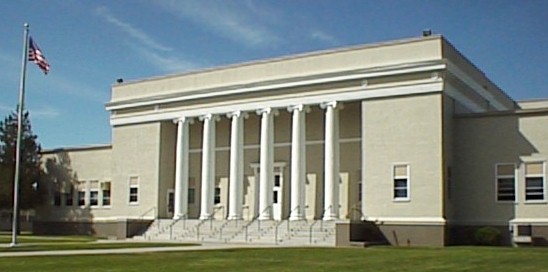
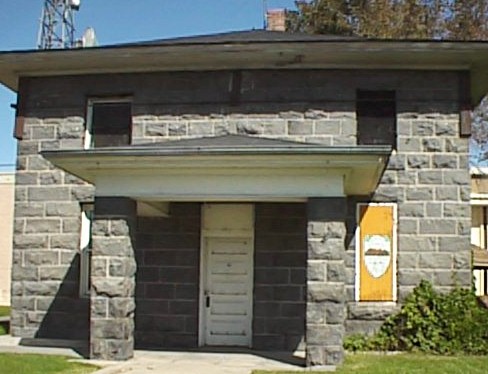
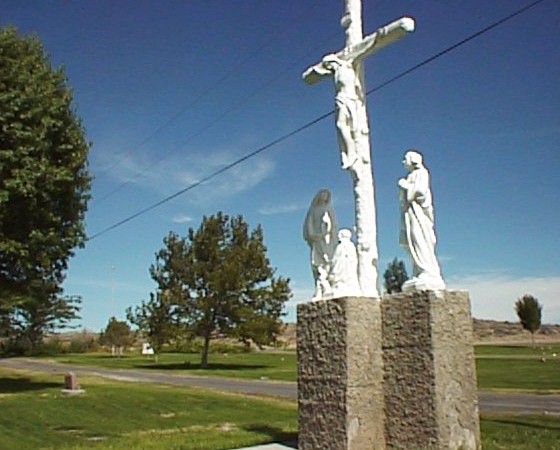
|
Copyright © 1996 - The USGenWeb® Project, NVGenWeb, Churchill County
Design by Templates in Time
This page was last updated 09/08/2024